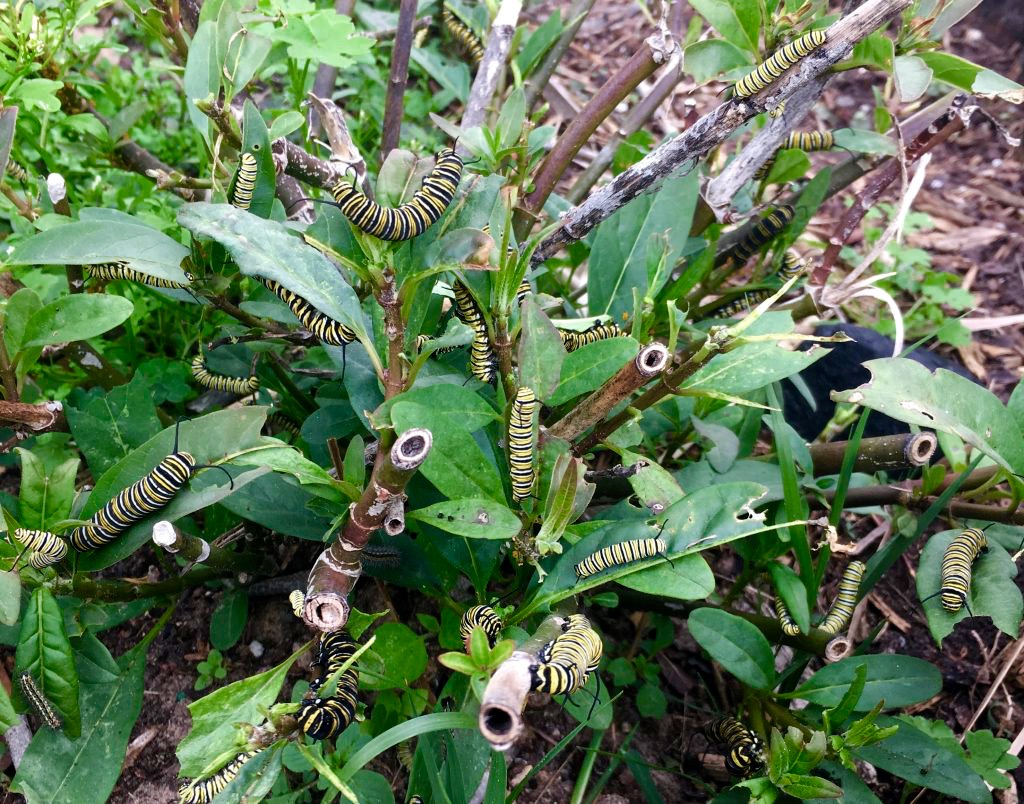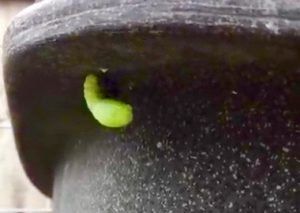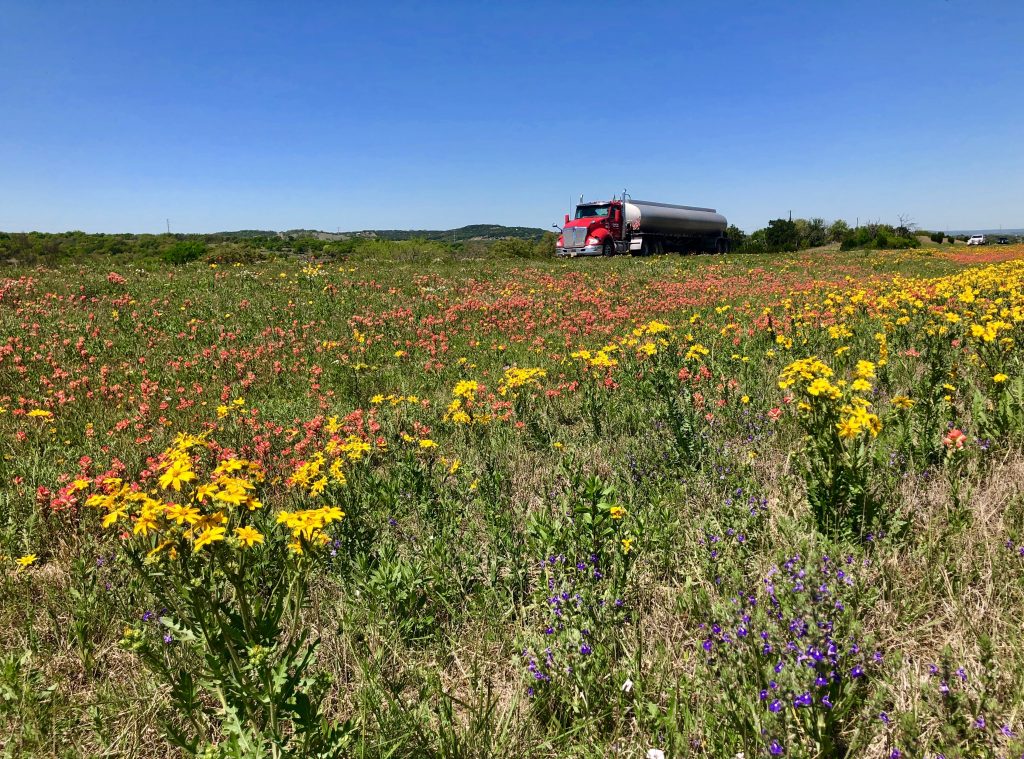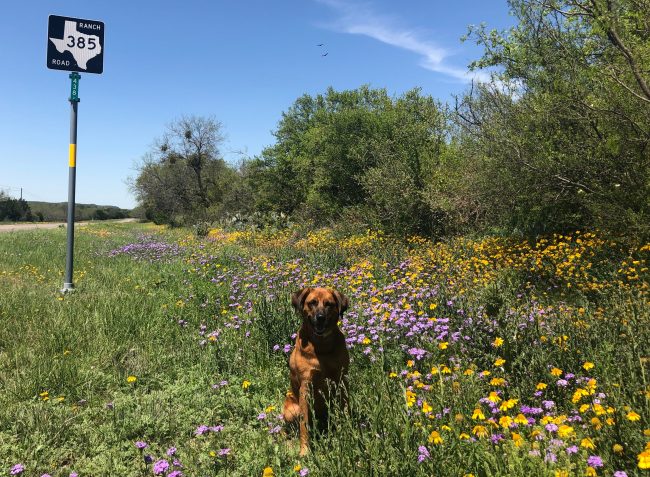South Texas is seeing an abundance of monarch butterfly caterpillars in recent weeks. Resulting chrysalises and butterflies suggest a robust 2019 monarch butterfly season as a bounty of wildflowers awaits.

Lots of hungry caterpillars in South Texas, here, at Quintana Beach Park near Houston. Photo by David Berman
Monarchs typically leave their overwintering roosts in the Mexican mountains in March to lay their inaugural round of eggs on milkweeds in South Texas gardens and wildscapes. The eggs hatch into caterpillars, morph through their stages, and form a chrysalis, then butterfly. The process takes about a month and launches the first generation of the seasonal migration that continues north through the fall.
“Six monarchs have eaten all the leaves on the two butterfly weed plants I have, what do I do now?” wrote Ann Newman of San Antonio earlier this week. Answer: buy more milkweed or let Nature take her course.

Monarch butterfly caterpillar transforms into a chrysalis under the lip of a garbage can. Video by Gabriela Santiago
“We literally have chrysalises everywhere!!!” said Gabriela Santiago, also in San Antonio. Santiago added that she counted 45 caterpillars on her Tropical milkweed in the Dignowitty Hill neighborhood. She also captured this video of a monarch butterfly transforming into a chrysalis under the lip of a garbage can.
David Berman, a graduate student at Oklahoma State University who’s been conducting research on milkweed and monarchs, confirmed the caterpillar palooza. “It’s crazy the number of eggs and caterpillars I’ve been seeing this spring,” he said.
Berman, who’s checked more than 55,000 milkweed plants in counties from Abilene to Mission over the last two years, cited hundreds of monarchs in all their stages. He counted 55 fifth instar–that is, the final caterpillar stage of the monarch before it transforms into a chryalis–at the San Antonio River Authority pollinator garden on the San Antonio River.
Berman pointed out that monarchs aren’t the only butterflies benefitting from good weather. Swallowtails, painted ladies and other colorful flyers are making the most of the welcoming wildflower season.
Caterpillar gallery by David Berman
The good news is that the butterflies that hatch will have plenty of nectar available to fuel their travels and reproductive escapades once they take flight. Spring wildflowers are showing their many colors in grand form.
According to the experts at the Lady Bird Johnson Wildflower Center, we’re moving from the early to the middle of wildflower season in South and Central Texas. “If it’s bluebonnets in Central Texas you’re looking for, they’re still going strong, but on the downturn from their peak about two weeks ago,” said Andrea DeLong-Amaya, horticulture director at the Center.
Last weekend’s dramatic storm system, which dropped four inches of rain in San Antonio, has precipitated a massive Indian paintbrush bloom, great displays of Indian blanket and winecup. They should be going for a while, said DeLong-Amaya. “Horse mint will be coming on soon, too.”
Temperatures and rainfall determine the length of the wildflower season. If a dry heat wave hits, the flowers won’t last as long.
Texas Department of Transportation has been planting native wildflowers along Texas Highways for more than 80 years. The department hired Jac Gubbels, its first landscape architect, in 1932, to maintain, preserve and encourage wildflowers and other native plants along rights of way, according to the TXDOT website.
Lady Bird Johnson, born in East Texas, evangelized for native plants and wildflowers, bringing the blooms’ special charms to the public’s attention during her tenure as First Lady of the United States during the Lyndon Johnson administration. Her legacy lives on every spring when wildflowers bloom on public lands across the country.

Indian paintbrush and Huisache daisies stole the show on IH10 west of Kerrville this week. Photo by Monika Maeckle
Safety first if you pull over to take pictures. Don’t disrupt traffic on busy or narrow roads, wear bright clothing (David Berman wears an orange safety vest), watch children and pets closely, and avoid dusk and evening photo outings. Better yet, find an area that is off-road.
Etiquette for appreciating wildflowers includes avoiding trampling, excessive picking or otherwise damaging plants. Heavy foot traffic kills plants and destroys their capacity to fuel pollinators like monarchs or produce seeds for birds. It also reduces the display for others to enjoy. “Generally, we encourage plant lovers to be respectful,” said Lee Clippard of the Wildflower Center.
For tips on what’s blooming now, check the Lady Bird Johnson Wildflower Center’s Wildflower Central website. The page offers general wildflower information, a Top 20 Bloomers list–even directions for regional drives that tout the showiest wildflower displays.
TOP PHOTO: Canine correspondent Brisket Rivard enjoys an offroad wildflower outing in Kimball County, Texas. Photo by Monika Maeckle
Related posts:
- Monarch butterflies head our way as big wildflower bloom awaits
- Migrating monarch butterfly populations vaults 144%, highest in 12 years
- How to raise monarch butterflies at home, Part 1
- Monarch butterfly population up in Mexico, down in California
- Monarch butterfly population drops 27%, freak sleet storm to blame
- Weird, late migration finally reaches Mexico
- Banner year for monarch butterfly migration? Texas Hill Country ready
- Five monarch butterflies tagged at Monarch Festival in San Antonio make it to Mexico
- New study: late season nectar plants more important than milkweed to Monarch migration
Like what you’re reading? Don’t miss a single post from the Texas Butterfly Ranch. Sign up for email delivery at the bottom of this page, like us on Facebook, follow us on Twitter, @monikam or on Instagram.


Great article,. Great News.
All my Mexican milkweed is gone and I am cutting wild milkweed from our pasture to feed my 26 larvae in my butterfly cage. This is so thrilling, I can’t stand it! Several of my friends are now into noticing and trying to help Monarch. I have never seen anything like this and I have been collecting and hatching them for about 10 yrs. I hope to get to San Antonio in October.
I counted 28 monarch caterpillars on our TX milkweed in San Antonio. I am sure there were more that I did not see. They ate the whole bed and as they matured they disappeared. I have no idea where the chrysalis’ are. Do they go to neighboring plants or under the deck? any ideas?
If the weather cooperates staying normal over the next 120 days, over 10 hectares will arrive in Mexico in November. Computer models don’t determine weather 🤠😎🤘🤣